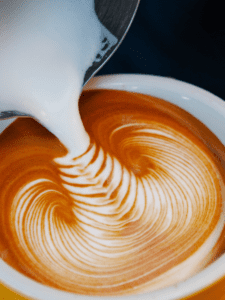 The pumpkin spice latte’s explosive popularity leads people to think it was the first popular seasonal coffee drink. However, it was crafted deliberately after another seasonal beverage’s success. After development, testing and release, this second seasonal beverage became so popular that negative reactions against it are ubiquitous. But is any of this negativity toward the pumpkin spice latte justified?
The pumpkin spice latte’s explosive popularity leads people to think it was the first popular seasonal coffee drink. However, it was crafted deliberately after another seasonal beverage’s success. After development, testing and release, this second seasonal beverage became so popular that negative reactions against it are ubiquitous. But is any of this negativity toward the pumpkin spice latte justified?
In this post, we’ll cover the historical and cultural placement of the pumpkin spice latte. We’ll also point to some potential downsides to indulging regularly in the store-bought PSL. We have an easy at-home pumpkin spice latte recipe that can rev you up for cooler weather (or just help you bear it), along with other holiday coffee recipes for all the double-digit months of the year.
History of the Pumpkin Spice Latte
The pumpkin spice latte was dreamed up and concocted on the heels of the peppermint mocha coffee drink that had adorned Starbucks’ menus the season before, in 2002. The peppermint mocha had been a success. Hoping to replicate its popularity, the company generated ideas for a beverage for fall. Two flavors that pair well with coffee, traditionally, are caramel and chocolate. These showed up on initial customer surveys and were pursued. However, the proposal of a pumpkin pie-flavored latte wasn’t a smash hit on the surveys and tests. It stayed on the company’s list of possibilities, nevertheless.
Taste testers tried actual pumpkin pie bites alongside sips of espresso. The taste tests continued for months, with rivals chocolate and caramel still in the running. The final recipe with pumpkin won. In the fall of 2003, its unique and decadent flavors were quickly ratified by the average consumer in two cities. The next fall, it was dispersed throughout the US and Canada. However, the true pumpkin spice latte boom happened after social media blossomed. Once people began sharing pictures of themselves drinking it, it soared to new heights.
Interesting Points about the PSL
A creamy, sweet latte’s ability to appeal to a younger crowd of drinkers can’t be ignored. Young adopters who would wait in line for it every fall had an impact. Young people under 25 have a surprising amount of spending power. They also increasingly gather at coffee shops. College students study and hang out at coffee shops, and teenagers want to follow suit. For years, Facebook was only available to college students. Once they were sharing pictures of their pumpkin lattes and selfies, the viral effect was powerful.
Pumpkin spice inflates prices. In fact, Magnifymoney.com has gone as far as to name a “pumpkin spice tax.” The average amount of the markup, added only because of pumpkin or pumpkin spice flavor, is 14.1%. Taking demand into consideration, sellers project that this is the extra amount people will pay. Sometimes the markup is as high as 161.1%. This enormous percentage was found in the price difference of Trader Joe’s pumpkin pretzels. There is probably a lot of overlap between TJ’s average customer and the average pumpkin spice latte lover!
A purer form of pumpkin was added to Starbucks’ pumpkin sauce later—in the form of puree. In 2015, real pumpkin puree jumped into the recipe. Reputedly, small kabocha pumpkins provided the puree. As the giant retailer becomes increasingly like a fast-food chain, who knows the state of the current recipe.
The pumpkin spice latte caused pumpkin to soar in popularity in the US and Canada. From candles to desserts to beer, pumpkin became the hottest ingredient for fall. Beyond just cropping up everywhere, in some ways, pumpkin became the symbol of fall. Interestingly, in other countries, pumpkins, sweet potatoes and gourds are more popular year-round. In Australia, these sweet and meaty vegetables are incorporated into dishes year-round. There’s even pizza topped with feta and pumpkin!
The Backlash
As with almost anything that skyrockets to popularity and sticks (except maybe Dolly Parton), not everyone is on board with the pumpkin spice latte. There are tons of funny jokes about it. Of course, there are some haters too. Here are a few quotes about pumpkin spice obsessions, for laughs.
Has the pumpkin overload during fall gone too far? A quote reads:
“Sorry you didn’t know your hot pumpkin drink was really a scented candle.”
Everyone must remember to look before they drink! One meme reads:
“If you say ‘pumpkin spice latte’ in the mirror 3 times, a white girl in yoga pants will appear and tell you all her favorite things about fall.”
Well, we must admit that a certain type of person may be predominately responsible for the drinks’ popularity. Nevertheless, the pumpkin spice latte is difficult for many people to resist.
The Truth Behind Some Negativity
Some negativity toward the pumpkin spice latte is just mean-spirited or cynical. Other criticism is more justified. It’s not just people’s tendency to follow the crowd into purchasing a fad that creates all this negativity. Hey, some people just don’t like pumpkin, or pumpkin spice!
Some people avoid admitting that coffee doctored to this degree with dairy and sweetener is basically a dessert. Which is fine, as long as you acknowledge it as such. Also, claiming an obsession or addiction to a drink that’s only around for a few months can drain your wallet. See the bit above about the markup on pumpkin spice products!
The pumpkin spice latte has brought fame, acclaim and money to a coffee corporation. Many people don’t realize the impact their purchasing decisions can have. They can either be a drop in a corporate profit bucket or support a small business or other coffee-selling organizations.
Chain coffee retailers displaced local coffee shops that can’t compete. Chains can withstand volatility better, and pool spending for business elements like marketing. Chains can price based on bulk shipments shared with other stores in the area. The lure and zeitgeist of chain retailers’ popularity might mask the fact that some local coffee shops and online retailers have better coffee. Also, by supporting local businesses, the money stays in the local community.
If you want to escape pumpkin mania, there is a way. In fact, if you want to counteract the hype causing the pumpkin tax to be possible, the path is the same. Great alternatives to reinforcing corporate dominance exist!
Honduran Coffee for a Good Cause
With Subida Coffee Co., coffee lovers choose a very different path from incentivizing gigantic coffee corporations. Instead of buying mass-produced coffee from a multinational corporation, you can support a great cause. Hints of chocolate and sweet citrus in the medium roast provide sweet flavors without all the calories of a pumpkin spice latte. Brown sugar and black cherry can be savored throughout the holiday season with Subida’s single-origin coffees.

More convenient than a location a few miles down the road, Subida delivers coffee beans from Honduras to your doorstep, or grounds if you prefer. With a subscription model, you need not make all the effort of reordering. Instead of choosing a multinational corporation, you can support an international non-profit.
Subida grows its coffee on a 120-acre farm in Santa Rosa de Copán, Honduras. An onsite boarding school educates local youth with the profits from the sales of Subida Coffee. Educating and fostering the development of young people helps build a brighter future for a remote area. Local adults grow the coffee at the direction of agricultural engineers, creating great jobs. Subida can help take back control of coffee sales in your community. It can be ordered for sale at a coffee shop, stall or store. Since most North Americans can’t buy coffee locally, it’s important to put your money towards the best coffee cause!

